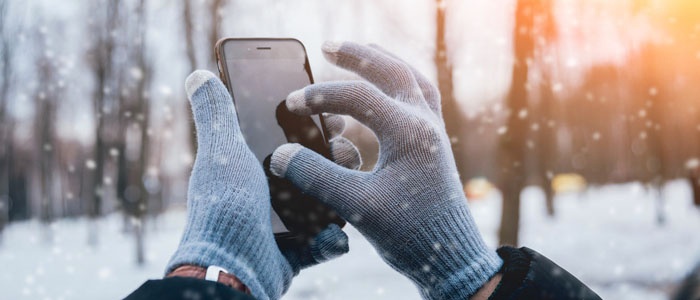
Winter weather can serve up some chilling risks for delicate devices. How can you avoid the most common accidents?
Every year, more than 45 percent of smartphones fall victim to accidental damage. However, during the winter months, treacherous conditions bring about a whole new set of potential threats, making cracked screens and liquid damage all the more likely to occur.
Here are some of the most common cold weather mishaps that, with a few simple changes, you can easily avoid.
Swipe, slip, shatter
Nearly 90 percent of people drop their phones once a month, with five percent of those claiming to drop their phones at least six times a month. As winter weather rolls in, these accidents can become even more prevalent. A quick slip on the ice can send you and your device crashing to the ground—and landing with your full weight on a delicate screen usually doesn’t make for a great outcome. And don’t forget what could happen when you slide off your glove to send a text – freezing temperatures have the ability to create cold hands that aren’t able to grip your device like usual. On average, it’ll cost you up to $250 to repair or replace a shattered screen.
Winter white is still wet
Despite the obvious lack of buoyancy, 28 percent of consumers take their devices for a swim every year. Whether it’s a dip in the pool or a drop in a beer, these wet whoopsies add up to be the number one cause of device damage annually. Now, factor in winter weather and the potential perils start piling up. Carry your phone in your back pocket? Your device has a greater chance to slip out and land in snow, ice, or slush. And even though the snow is frozen, it can still seep into your device and melt, causing irreversible damage. So, while snapping pictures of the kids sledding seems like a great idea, one slip and excess moisture can quickly ruin the fun.
No market for device-icles
When temperatures drop, we just grab an extra hat and gloves to stay warm. Unfortunately, your wireless device doesn’t have that option. Temperatures below negative four degrees can cause devices to experience battery death, internal component errors, rigidity, and liquid condensation—all of which are considered irreversible damage. To prevent this grim possibility, never leave your phone in the car during the winter and, if you find yourself outdoors, limit exposure by only using it when absolutely necessary.
The winter season can be fun, but it’s a particularly dangerous time for wireless devices. Cold temps and slippery conditions can lead to unfortunate damage—damage that’s avoidable. But if you want to be extra sure that your device is protected during the winter months and beyond, a Fortegra wireless protection plan can do the trick.
For more insight on who might be at risk for wireless device damage no matter the season, check out our blog on the three demographics that need device protection the most.
Fortegra® is the marketing name for the warranty operations of Fortegra Financial Corporation and its subsidiaries.



